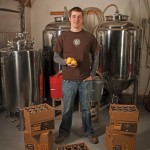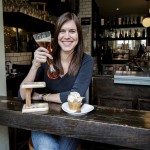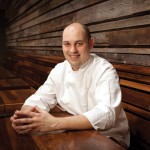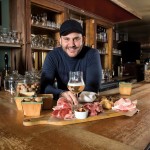6 beer & food innovators
Meet the half-dozen innovators who are changing the way we eat and drink right now.

THE NANOBREWING CHEF: Ian Clark
Ian Clark doesn’t believe in shortcuts. Whether he’s brewing a barrel of keg-conditioned, date- and caramelized sugar-infused brown ale or curdling a batch of goats’ milk ricotta cheese, the owner and self-titled “beer chef” of BRU Handbuilt Ales and Eats in Boulder, Colo., thrives on being methodical. “We’re not going to cut any corners,” says Clark of the 65-seat brewpub, slated to open this spring. “Every single thing that’s going to be eaten in the restaurant will be made by us.” Housemade cheeses, charcuterie, breads and desserts will anchor BRU’s rustic, gastropub-style menu, whose made-from-scratch ethos mirrors Clark’s brewing philosophy. After homebrewing for a decade, the 33-year-old New England native launched BRU in his Boulder garage in 2012, producing 55 unfiltered, naturally carbonated barrels the first year. Using the keen palate and attention to detail he honed during his culinary training and years spent cooking at restaurants nationwide, Clark teases subtle food flavors from his brews, such as fresh lemon zest and juniper berries in Citrum IPA and black pepper, honey and orange peel in Beezel, a Belgian-style golden ale. The new 3,000-square-foot, 500-annual-barrel facility will provide brewing space for a variety of styles—including a roasted pumpkin porter, a rye IPA and a saison—and will at last unite Clark’s twin passions under one roof. “I made the beer that I like and the food that I like, and inevitably they just sort of meld together and become one,” Clark says. “It’s hard to think of one without the other.” –Sarah Stewart

THE BAKER: Marlo Scott
For Marlo Scott, cupcakes and beer weren’t always so formally linked. When she started Sweet Revenge, her small West Village establishment, she encouraged patrons to have a drink with one of her decadent pastries, but they were reluctant. So Scott developed a pairing menu, putting a Cafe Mocha cupcake with Young’s Double Chocolate Stout, or the Sweet Revenge pastry (peanut butter cake with ganache filling and peanut butter fudge frosting, topped with crumbled peanuts and dusted with cocoa) with a Weihenstephaner Hefe Weiss from Germany. “It took off,” Scott recalls. Five years later, she’s still mixing and matching a small but eclectic mix of international beers with her out-of-this-world cupcakes. Frequently, a beer informs changes to the menu, whether it be a Rodenbach sour (paired with an orange creamsicle cupcake) or Belgium’s strawberry Fruli. “Once I tasted that, I knew I had to have it,” the former corporate finance executive says. “We started playing around with pastry so I could justify having it on the menu.” Fruli inspired the Fresas y Nueces, an almond cake with strawberry walnut cream cheese frosting. Marlo and her team are debuting a dinner menu, sticking with international flavors suggested by the beer list, and the European feel of the café’s Carmine Street location. One thing’s for sure: They have dessert covered. –Noah Davis

THE BELGIAN VET: Bart Vandaele
It’s hard to imagine a beer-and-food culture more tradition-steeped than Belgium’s, whose centuries-old brewers’ guild bestows knighthood on its inductees and whose culinary roots extend to the Middle Ages. But if you think Belgian cuisine is static or one-dimensional, chef and native son Bart Vandaele wants to prove you wrong. Though he’s known for introducing Washington, D.C., palates to Belgian classics like mussels, frites and hearty, beer-based stews and sauces since opening Belga Café in 2004, Vandaele’s latest venture takes more creative license with his home country’s cuisine. At B Too, his whimsical, 175-seat restaurant opened in April in downtown D.C., Vandaele repurposes dishes from his childhood into healthier, more contemporary versions—from panko-fried frog legs in a tomato-cream sauce to a mushroom- and couscous-infused waffle at the waffle and frites bar. “We’re definitely a little bit more playful, a little more sexy,” says Vandaele, a “Top Chef” season 10 contestant and member of Belgium’s prestigious Knighthood of the Brewers’ Mash Staff. “We took classic Belgian dishes, broke them down and made them lighter.” B Too does borrow a few of Belga’s traditional elements—namely its beer list of 150 almost exclusively Belgian brews, including 12 taps and lots of large bottles. But even the beer gets Vandaele’s own spin, with his house-recipe brew. “After a while doing the same thing over and over, and growing up with certain things, you want to reinvent it,” he says. “It proves that Belgian cuisine is very versatile.” –Sarah Stewart

THE BEER-DINNER MASTER: Chris Lively
The best beer dinner in America doesn’t take place in New York City or San Francisco or Chicago. It’s in Lovell, Maine, a town tucked away in the foothills of the White Mountains on the western edge of the state. Chris Lively, who owns Ebenezer’s Restaurant & Pub with his wife, Jen, started hosting beer dinners when he tended bar in the late 1990s at Lucky Baldwin’s in California (he even cooked for the Belgian ambassador to the United States), but it wasn’t until he and Jen opened up Ebenezer’s in 2004 that the king of all beer dinners was born. It happens each August the Thursday night before Ebenezer’s annual Belgian beer festival. If you’re lucky enough to snap up one of the 110 tickets (nearly 4,000 people sit on a waiting list every year), you’ll be treated to a five-hour feast of a lifetime cooked by a cast of chefs like Christophe Pelfrene and Stefanie De Vos from Belgium’s De Bistronoom, and paired with 20 or so Belgian and Belgian-inspired beers. “It’s the one day of the year dedicated to the beer geeks of the world,” Jen Lively says. The night starts off with a selection of welcome beers and cheeses selected by beer-and-cheese maven Ruth Miller, before transitioning into an epic 12-course meal. Plate after plate of creative Belgian cuisine like decadent smeus—potato puree with caramelized leeks, poached eggs, lobster, caviar and hollandaise sauce—is paired with gorgeous Belgian brews like Fantôme BBB Pop. Be prepared for at least one vertical tasting interlude: Lively pulls a string of brews from his $7.5 million cellar, regarded as one of the finest collections in the world. Afterward, there’s a rocking party where Lively opens up an “Oh f**k beer”; last year he uncorked a magnum of 1902 King’s Ale. This year will prove to be full of surprises, but here’s a sneak peek: At least two of the courses will be dedicated to late Master Brewer Darryl Goss, and Lively plans to pull a 1992 New Glarus Apple Ale to pair with one of the courses. While it’s just about impossible to get a ticket for this event, Lively stages other, more casual beer dinners on New Year’s Eve and Valentine’s Day, as well as a “vintage beer dinner” each spring, at both Ebenezer’s and its sister pub, Lion’s Pride, in Brunswick, Maine. But the Belgian beer dinner is the mother lode. “There’s nothing like this dinner anywhere else in the world,” says Lively. –Carolyn Malcoun

THE INDUSTRY DARLING: Adam Dulye
The Abbot’s Cellar, housed in a spacious former garage on San Francisco’s Valencia Street, opened last year with a clear mission: to take beer as seriously as a traditional dining room takes its wine. Chef and co-owner Adam Dulye runs the restaurant’s forward-thinking kitchen. A typical night might find him searing local pheasant to meet a warming pour of Westmalle Dubbel, or smoking steelhead with an eye on Alesmith’s Anvil ESB. Forget burgers and pints; here, your fourth course might come with a sour ale served in a Burgundy glass. Dulye became interested in craft beer while cooking in Kansas City in the early 1990s and watching Boulevard Brewing enliven a previously lackluster Midwestern beer scene. He later trained at the Culinary Institute of America in New York, toured France to study more, and worked at restaurants in Oregon and Colorado. While running the kitchen at the Manor Vail Resort, he started organizing regular beer dinners—particularly during ski season, he found it easy to entice brewers to visit and present their wares. Soon, he was collaborating with organizations like the Brewers Association and the Colorado Brewers Guild to expand the role of craft beer in fine dining. A serious vote of confidence came in 2009, shortly before he moved to San Francisco: He was invited to present a beer pairing dinner at the esteemed James Beard House in New York. He presented a second dinner there in 2012. Speaking of Beard, last year Dulye got a chance to step out of the kitchen and into the brewery when he teamed up with Sam Calagione of Dogfish Head to brew a beer dedicated to the culinary icon. They included some of Beard’s favorite ingredients, like green peppercorns and Rambo apples, and called it Beard De Garde. –Luke Sykora

THE MEAT GUY: Christian Pappanicholas
A love of meat runs in Christian Pappanicholas' family. His father owned two restaurants, and his mother cooked constantly when he was a child. “We roasted a whole lot of animals,” the proprietor of New York City’s Resto and The Cannibal says with a smile. The former competitive tennis player jumped into the restaurant world after a few years in commercial real estate and a six-month stint at the French Culinary Institute. The Cannibal, a beer-and-butcher-shop-cum-restaurant, brings together Pappanicholas’ fondness for outlandish cuts of meat and beer; the menu offers more than 450 bottles. Pairing them perfectly is about feel. “It’s not an exact science. I’m way more risky. I don’t try to get things to be exact,” he says. “I never want beer to feel so fussy that it always has to be about the pairing.” Soon, The Cannibal will venture into vintage beer—there’s $10,000 worth of inventory, including 10 cases of Orval, sitting in the basement’s coolers—but the focus now is on sour Belgian brews and dishes that complement them. “Take a boudin noir. It’s fat with a small amount of lean meat, and all those warm spices and blood. What’s the really fun part of that sausage? The really rich, dark, iron-driven flavor profile with the warm spices. It’s easy to grab a Rodenbach Grand Cru and say, ‘Here you go,’” Pappanicholas says. He makes it sound so simple. –Noah Davis









